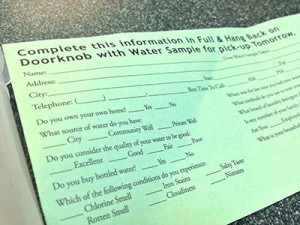This chronology has some serious leaks, and we welcome you to contact us with any further information or clarifications. Many thanks to Tom Renner of E.H. Renner and Sons, Inc. for much of the information in this section. Also see Tom’s memoir in Something in the Water.
For information about water pollution by Reilly Tar and Chemical, see the Creosote Plant.
In 1891 the Minneapolis Land and Investment Co. platted 2,000 acres in the heart of St. Louis Park. The company retained the right to install, among other things, water or gas mains or conduits.
Minneapolis began providing homes with running water in 1895. [Unverified fun fact: the first separate bathrooms for men and women appeared in Paris in 1739.]
In 1911 Leslie Max Renner, Sr. moved to St. Louis Park. Max had come from a family of well drillers in Berlin, Germany, and had established the Max Renner Well Company in south Minneapolis in 1895. By the turn of the last century, the Park was growing and each new home and business required its own well. Max moved his business west when he found that he was spending too much time travelling back and forth with his horses and wagons.
In December 1918, Max Renner, Sr. and his 19-year old son Percy were killed at 44th and Wooddale by the high speed Excelsior Street car. It was a very foggy morning and a newspaper account reported that the road and the streetcar rails were wet. The Max Renner Well Co. was taken over by Leslie Max, Jr., and his brother, Edwin H. Renner. A third brother, William, was installing windmills for another company.
1922
The McAlpine Well Company was located at 1333 Kentucky Ave. at Wayzata Blvd., according to the ad below from the 1951 directory.
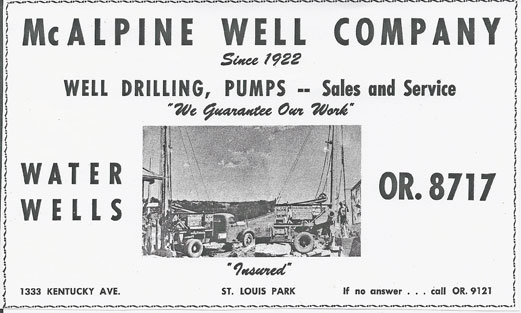
1924
In 1924 Tom Motzko became Park’s first (and for a short while only) plumber. Tom Motzko Plumbing continued through three generations until the company closed in 2016.
Also in 1924, plumber Gust Hoglund started plying his craft in the Park, from his home located just southeast of Wooddale Lutheran Church. By 1961, the one-man operation had grown to a plumbing and heating corporation employing 50 people and headed by Gust’s son Don. The office had moved to 7420 West Lake Street, which was built in 1955.
1930
Sewer District #1 was approved in April 1930. Alexander and Bradley were the Village Engineers. The Park water system was installed with WPA help.
The first plumbing ordinances were passed on July 9, 1930. Joe Williams was appointed both Fire Chief and Superintendent of the water system. He was succeeded by Ira Vraalstad, who and had done a lot of the work for the contractor who put in the original water mains.
The first patron signed up to be connected to the water main on August 25, 1930, was the Church of the Holy Name. This is probably Holy Family Church, which was started in 1926. A certificate was made out, in lovely longhand script, each time a building was connected to the water main.
1931
One local plumber who did a lion’s share of those early connections was Tom Motzko. In 1931 he was found to be plumbing without a license, but the Village Council gave him the chance to take the test.
1932
At the Village Council meeting of April 25, 1932, the council awarded contracts for the immediate construction of the waterworks system which it has been planning for several months,” reported the Hennepin County Review. The McCarthy Well Company won the contract to dig the well ($1,775), and the Chicago Bridge and Iron Works won the bid for the tower and tank ($6,745).
1933
In 1933 E. H. Renner left the Max Renner Well Co. and went into business for himself, forming the Edwin H. Renner Well Drilling Co. His brother Bill also had a well drilling business on Minnetonka Blvd. just west of the current Highway 169. Max’s son Leslie Max and then his son Les stayed with the Max Renner Well Co., until the early 1960s. It moved to Highway 7 by Nordic Ware and then to Hopkins.
In the 1933 Street Directory, the Water Department reported that there were 329 water meters installed.
Park pumped its first local water, which stunk. Stank. The September 3, 1933, Minneapolis SundayTribune showed Joe Williams with a horrible expression on his face as he tasted the local brew – the headline read: “Phooey! Says Water Expert.” See Republic Creosoting for much more about the leaching of creosote into St. Louis Park’s water supply.
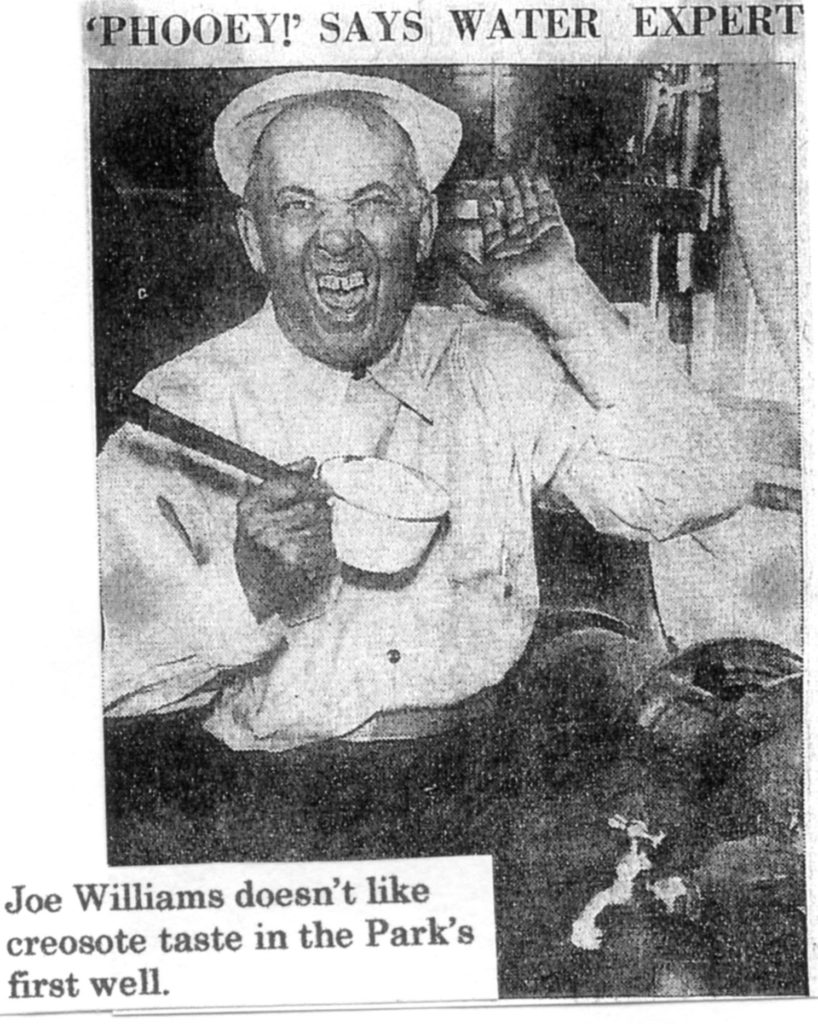
1934
In 1934 Joe Smith, 4133 (35) Zarthan, advertised as a well driller. His wife’s name was Bertha.
In 1932 the McCarthy Well Co. drilled a 16 inch well behind the old fire station at 36th and Brunswick. Bergerson-Caswell, a company from back East, built the 180 ft., 100,000 gallon water tower. It was designed to serve 600 customers.
After using the creosote-tasting well for about eight months, the Village Health Department shut it down, and a connection was made to Minneapolis city water at France Ave. and Minnetonka. The installation of these first water mains allowed the fire department to buy a pumper truck for the first time. City water pipes were installed on most streets and avenues. The McCarthy well was idled but not destroyed for many years.
1935
In 1935 Clifford J. Browne was issued a plumbers license. Browne’s home and shop were located on Wooddale, where he lived with his four children and wife Lorraine, who did the firm’s bookwork. Browne’s daughters remember his first advertising slogan, created by their brother: “This is Cliff – Drop Over Sometime.” The business came to an end in 1954 when Lorraine was killed as a pedestrian (by a city bus) on her way to church on Good Friday. Browne never got over the loss and had to be institutionalized for the rest of his life. For a memoir of their father written by his family, see Something in the Water. Ad below from 1951 directory.
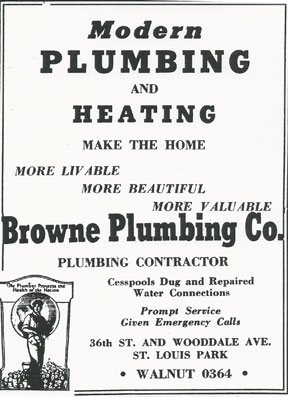
1937
In 1937 the Max Renner Well Co. drilled two shallow wells at 29th [Minnetonka Blvd.] and Idaho. Water was pumped from the Platville limestone and the St. Peter sandstone to filter out the creosote. The location was chosen with the premise that groundwater flows from northwest to southeast in another effort to avoid the creosote. A deal had been made with a Minneapolis bank to put up the money for the well, and the Village would then purchase the water from the bank.
The first well was 285 ft. deep, and hopes were high that it would serve the entire community. However, these wells were pumped too hard, they delivered a lot of sand, and the over-pumping pulled the creosote over. These wells were sealed by E.H. Renner and Sons, Inc. in the mid 1950s.
A 1937 news article shows Village Health Commissioner Dr. Darby holding up a sample of the new water; he claimed that it was free from all bacteria and softer than Minneapolis water. The well drillers knew that it was harder than Minneapolis “river water” and that it contained about 3 parts per million of iron, which left stains.
1938
The water system was considered completed on June 17, 1938, serving 800 families.
1940
An ad placed in the Minneapolis Tribune on March 10, 1940 stated that “a municipally operated artesian water system with 150 miles of water mains provides the village with pure, unadulterated water.” A similar description is in an (unfortunately undated) article by Lydia Rogers, who calls it “unsurpassed water, powered by pumps dispensing 1,500 gallons of 50 degree pure unadulterated water per minute, directly from three wells out of the metropolitan artesian basis.”
In 1940 Tom Motzko had 50 men on his payroll. He had plumbed the Park Theater the year before.
In November 1941 construction started on the 500,000 gallon (and 23,000 in the riser) water tower located “250 feet south [sic] of the center of the Minneapolis-Excelsior Road” at Highway 100 (at Lilac Way Shopping Center). It went into operation about July 1, 1942, and cost $42,260. It was the Village’s second such tank. The sign “St. Louis Park” was donated by the Pittsburgh Des Moines Steel Co. The tank was demolished on September 1, 1994.
1941
Marie Hartmann noted that the Water Department was established on December 29, 1941.
1942
On June 26, 1942, the Dispatch reported that the Village used 18,550,000 gallons of water monthly serving 2,500 buildings. The water superintendent was Ira Vraalstad.
On November 6, 1942, the Dispatch had a cryptic item saying that the bonding company would pay the shortage in the Water Department funds during the term of Mr. R.M. Porter. Porter had been arrested several weeks ago.
1944
The August 18, 1944 issue of the Dispatch reported a severe water shortage that cut water pressure in homes to nothing at certain times. The Fire Department was concerned that there was not enough water to fight fires. “Both pumps” were working full time but could not keep up with demand. Between five and six hours were required to pump the necessary 600,000 gallons of water back into the mains in order to bring the water pressure back to normal. During the previous week the tanks were emptied as early as 10:00 in the morning.
1945
In June 1945 The War Production Board lifted its restrictions against laying sewer lines and the Village Council was able to advertise for bids for jobs under $25,000. Many residents were waiting in line for sewer and water service.
1946
In the fall of 1946 Scotty Hudson was apparently living in the west half of the Village Pump House. The address given in 6021 W. 36th Street, but that’s not an address today. It was no doubt at the location of the first tower at Wooddale and 36th, now gone.
In December 1946, Village Well #5 was purchased from Emil Duemke for $2,500. It was located west of Texas and south of 34th Street.
1947
In 1947 there was pressure put on the Village Council to extend the water system, but the village still owed $132,000 on its $480,000 system. The problem was solved in 1950 when they put out a $488,000 bond issue.
In 1947 Ed Renner’s sons Edwin R. (“Eddie”) and Tom joined the company when they returned from the Service. An ad from the 1947 Park Directory shows a proud father at his desk and his two strapping sons standing by one of their trucks. The company name was changed from the Edwin H. Renner Well Drilling Co. to E.H. Renner & Sons.
The daughters of plumber Clifford J. Browne describe how some of the new developments were built. Foundations would be set into block-long trenches that had been dug by heavy machinery. Cesspools and waterlines were dug by hand by “diggers.”
1949
In May 1949 the Village bought 20,000 gallons of chlorine from Hawkins Chemical for 12 cents/gallon. For the water supply?
From 1949 to 1951, John F. Hazalik and Son, Well Drillers and Pump Repair, was listed in the directory at 4615 Minnetonka Blvd. This building no longer stands.
1950
In mid-1950, a one million gallon water tower was built at the cost of $265,000. Tower 3 was built at 8301 W. 35th Street and served the Oak Hill area.
Johnson Brothers Plumbing and Heating was located at 4514 Excelsior Blvd. in 1950. The company, owned by Fritz Johnson, seemed to move around a bit.
1951
By 1951 water mains served 6,500 users. Water was pumped by six deep wells, with the pressure delivered by three overhead tanks with a combined capacity of 1.6 million gallons.

Sewers obviously went in on Brook Lane in 1951, as resident Harold Johnson raised a concern that the construction “might do great damage to his mink kits.”
1952
In 1952 complaints were made about people dumping sewage into the sewer manhole at 36th and Wooddale during working hours. Nels Larson was caught in the act.
1953
In 1953 water tower No. 4 was built at Cedar Lake Road and Louisiana. That same year, on September 18, there was a drowning in the water main trench at 23rd and Hampshire.
1956
In 1956 the City Council passed an ordinance regulating the licensing of persons installing water softeners. Also in 1956, well driller Tom Renner came before the council to alert them to the fact that people were taking pumps out of their wells and using them for sumps. An ordinance was ordered regulating abandoned wells.
1958
In 1958 E.H. Renner & Sons incorporated, and Ed Sr. retired that July.
An ordinance licensing and regulating well drilling was enacted on March 10, 1958.
The Ron-Son Sewer Service is listed at 4820 Minnetonka Blvd. (an office building) in the 1958 directory.
1959
By 1959-1960, sewer systems were in place throughout the City.
1960
In 1960 it was determined that 35 percent of all private wells in the Park were contaminated. Nitrites were found in the water, and indication of sewage recirculation. In March, three of the ten City wells (Wells 1-3 at Idaho and 29th) were shut down for contamination. Dr. Ellen Fifer, City Health Officer, argued for a municipal water system and the elimination of private wells.
The D.A. Oil Company building had been built over the Milwaukee Railroad well, which was located just east of Wooddale Avenue, 150 ft. south of the tracks [later the site of the Unpainted Place]. In 1960 E.H. Renner and Sons was hired by the State of Minnesota to seal it. It was well hidden, and had to be located with the help of old pictures from the St. Louis Park Historical Society and from Harold Hofstrand, a local surveyor. The Renners had to jack-hammer the floor to find it, then slide a well rig (without wheels or a tower) to get over the well. They cut a hole in the roof, then hired a crane to re-install the rig tower. They cleaned out the 945 ft. well and pumped it full of cement from the bottom up. A 4 inch casing was grouted in for use by the U.S. Geological Survey.
E.H. Renner & Sons moved out of St. Louis Park to Plymouth in 1960. They moved again to Ramsey, Minn., in 1972. Tom Renner’s twin sons Raymond and Roger entered the company in 1973. In search of more room and better proximity to new business in outlying areas, the firm relocated to a 50-acre tract in Elk River in 1985. The company is now in its fifth generation of the Renner family.
In 1960 Mead Well Drilling was working 24 hours a day to dig well #11, to the distress of the neighbors, who complained to the City Council and got them to cut it down.
1965
Rusty water was addressed in 1965 when two iron removal treatment plants were put in, one at 42nd and Zarthan, and one at Alabama and Cedar Lake Road. The contractor was Peterson-Templin.
The City chose not to include water softening when the first water treatment plants were being constructed in the 1960s. Retrofitting those plants to provide soft water would necessitate the taking of homes and prohibitively high water rates. St. Louis Park water is 18 grains hard; anything over 10.5 grains is considered “very hard.”
PARK FLUORIDATES
On January 6, 1951, local dentists urged the Village to add fluoride to the water. It would take another nine years. An article from 1960 notes, “Traditionally ultra-conservative, this body seldom recommends anything.”
Despite the delay, Park was the first community in the area to fluoridate its water. On April 11, 1960, the City Council 5 to 2 to approved the purchase of equipment to add fluoride salt to the municipal water supply. The $7,226.50 contract for equipment was awarded to Wallace & Tiernan. The City Council meeting was jam-packed with citizens who were both for and against the measure. In those days it was common to hear the charge that fluoridation – put in the water to strengthen teeth – was a “communist plot.” Other possible uses were to “poison the public, get rid of waste materials at a profit, and unlawful foistering of medication upon the people.” Speaking for the measure were Dr. Robert Green of the St. Louis Park Medical Center, dentist Dr. Walter Johnson, Dr. Jordan from the Minnesota Department of Health, and a representative of the Jaycees. The equipment, some of which had to be made to order, was to be installed at seven municipal well sites: Idaho and 29th (2); Natchez and 41st (well no. 4), Wyoming and 34th; Zarthan and 42nd; Louisiana and Cedar Lake Road, and Lancaster Ave. and 16th.
Charles Friedheim came before the City Council and requested permission to place an antenna on a city water tower. The Council voted no, but it turned out that the Minneapolis Gas Co. had one, the city attorney was instructed to negotiate a lease, and the city manager was told to develop a policy.
1963
The 1.5 million gallon reservoir near the intersection of Yosemite and Vermont was put into operation in September 1963. It was built by Minneapolis Tank and Manufacturing, and necessitated the removal of the house at 4231 Yosemite. Property was also purchased from Mrs. Anne Spencer, 4349 Brookside, for $3,000.
1981
In 1981 Tom Renner retired from E.H. Renner and Sons, and his brother Eddie retired two years later. The firm is now owned and operated by the twin sons of Tom Renner, Roger E. and Raymond T. Renner. It is the largest water well drilling business in the State in Minnesota.
In May 1981 the city announced that it would like to sell Park’s first water tower, built in 1932. It was located at 37th and Brunswick, which was convenient for all the Central Jr. High kids who constantly changed the name of the City to St. Louis Bark. The tower held 100,000 gallons, and too many instances of overflowing led to its shutdown two years earlier. The well beneath the tower had been closed for 30 years. The tower was primarily used as an antenna for a civil defense radio operation that met in the building beneath the tower. Plans were to sell the structure to Color Ad, a nearby business; $400 for the land, with the company dismantling the structure. Follow-up information is scarce, except that the structure was torn down in 1983.
1982
In 1982 the City hooked up to Plymouth’s water system to provide water for the Shelard area of St. Louis Park, at a cost of $30,269.
1983
In 1983 well #17 was completed at a cost of over $400,000. The well had to be drilled to meet some unique specifications so that contamination from aquifers close to the surface would not reach the well.
1989
This event in November 1989 is so strange that we’ll let Mickey Tibbits of the Sun tell it:
Freak Accident Implodes Tower
Looking suspiciously like the Tidy Bowl man, a water tower inspector was paddling in a rubber raft inside the tank near Highway 100 and Excelsior [Blvd.] when something unexpected happened.
As the half million gallons of water were released from the tank, he paddled around the interior Nov. 2 looking at the paint and the structure for possible damage.
“When the water was down to the last couple feet, the inspector used his paddle to swish away the murky water to get a better view of the bottom of the bowl,” said Jim Grube, director of Public Works. Grube compared the water draining out of the water tower to the vortex of a sink emptying.
When the inspector was using the paddle to clear the water, his raft got sucked over the riser pipe, the 24-inch center pipe that carries water from the underground to the bowl. Realizing the potential danger of the vacuum being created, he tried to use the paddle to get the raft off the grate covering the riser pipe. When that effort failed, “The inspector took his knife out and stabbed the raft trying to break the suction, but it was too late,” Grube said.
The walls of the riser pipe collapsed.
Grube said the inspector, Shawn Mulhern of AEC Engineering, was scared but not physically hurt. The center pipe currently resembles a flattened straw.
1994
That same water tower was dismantled in November 1994. At first, redevelopment plans worked around it, thinking it was too expensive to take down. One plan for the redevelopment of Lilac Way Shopping Center was actually called Tower Place. The tower was ultimately replaced with a one million gallon tower located in the Belt Line Industrial Park south of Highway 7 and east of Highway 100.
Every year the City produces a Water Report that provides the results of its water monitoring activities.
2003
In 2003 water tests showed increasing levels of alpha radiation, which has been linked to cancer and other diseases. The City upgraded its water treatment plants and used hydrous manganese oxide to remove the radium. That process was completed in 2012.
2012
In December 2012 the City of St. Louis Park warned residents about a water testing scam in which an unidentified third party may be trying to obtain personal information. The scam involves a small tube being left at a residence along with a card that asks for personal information (see photo below), such as household income. This is NOT coming from the city–if the city was testing your water, you would be contacted beforehand via official city letterhead.
THIS IS A SCAM!! DO NOT RESPOND!!
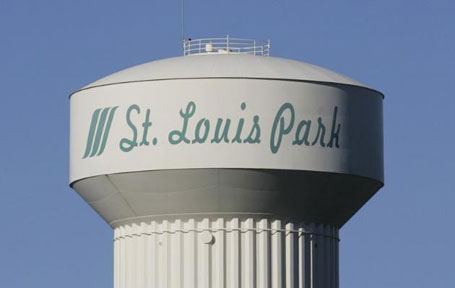
PARK’S WATER INFRASTRUCTURE
In 2015 the water system consisted of 11 active wells, 6 water treatment facilities, three one million gallon water towers, four reservoirs with a capacity of 6.5 million gallons,148 miles of underground water main, and 1,700 fire hydrants. The following is an attempt to list St. Louis Park’s water resources. The information was gathered from several sources, including Village/City Council minutes. It is NOT official, complete, or guaranteed correct, but a work in progress. If you have any insight into these facilities, please contact us.
| Location | Gallons | Yr. Built | Builder | Yr. Decom | |
| TOWERS | |||||
| Tower 1 | Wooddale & 36th | 100,000 | 1932 | Bergerson-Caswell | 1979 |
| Tower 2 | Lilac Way – 4236 Excelsior | 500,000 | 1942 | 1994 | |
| Tower 3 | 8301 W. 34th at Wyoming – Elie Park | 1 million | Oct. 1950 | Pittsburgh-Des Moines Steel Co. | |
| Tower 4 | 2541 Nevada (CLR & La) – Cedar Knoll Park | 1 million | 1953 | ||
| Tower | 5100 Park Glen | 1 million | 1994 | Pittburgh-Des Moines Steel Co. | |
| RESERVOIRS | |||||
| Reservoir 1 | 2900 Idaho – Bronx Park | ||||
| Reservoir 3 | 8301 W. 34th at Wyoming – Elie Park | 1959 | |||
| Reservoir | |||||
| Reservoir 6 | 4241 Zarthan | 1.5 million | 1963 | Mps. Tank & Mfg. | |
| WATER TREATMENT PLANTS | |||||
| TP 1 | 2900 Idaho – Bronx Park | 1.7 million |
1985 |
Calgon Carbon Corp. | |
| TP 3 | 8301 W. 35th at Wyoming – Elie Park | ||||
| TP 4 | 4701 W. 41st at Natchez – Susan Lindgren | 1991 | |||
| TP 6 | 4241 Zarthan | 1965 | |||
| TP | 6007 CLR at Ala. | 1963 | Mpls. Tank | ||
| TP 8 | 9701 W. 16th St. – Kilmer | 1970 | |||
| TP 16 | [Flag & Franklin] | 1974 | |||
| IRON REMOVAL PLANTS | |||||
| Iron removal | 4241 Zarthan | 1965 | Peterson-Templin | ||
| Iron removal | 6007 CLR at Ala. | 1965 | Peterson-Templin | ||
| WELLS | |||||
| Well 1 | Wooddale & 36th | 1932 | McCarthy Well Co. | 1951 | |
| Well 2 | 2900 Idaho – Bronx Park | 1937 | Max Renner | 1950s | |
| Well 3 | 900 gpm | 1939 | |||
| Well 4 | 4701 W. 41st at Natchez – Susan Lindgren | 1250 gpm | 1946 | (11/1979) | |
| Well 5 S | [Texas & 34th] | 1947 | (8/1981) | ||
| Well 6 | 4241 Zarthan | 1200 gpm | 1948 | Peterson-Templin | |
| Well 7 S | 2541 Nevada (CLR & La) – Cedar Knoll Park | 1952 | (11/1978) | ||
| Well 8 | [7600 Hwy 7 – Knollwood Church] | 1200 gpm | 1955 | Arch. Brandhorst & Leadholm | |
| Well 9 S | 1956 | (11/1978) | |||
| Well 10 | 6007 CLR at Ala. | 1250 gpm | 1955 | Peterson-Templin | (11/1978) |
| Well 11 | 1000 gpm | 1960 | Mead Well Drilling | ||
| Well 12 | 1150 gpm | 1965 | Keys Well Drilling | ||
| Well 13 | 1200 gpm | 1964 | Layne-Minn Co. | ||
| Well 14 | 1200 gpm | 1965 | Bergerson-Caswell | ||
| Well 15 | 1250 gpm | 1969 | (11/1978) | ||
| Well 16 | 1150 gpm | 1973 | |||
| Well 17 S | 1250 gpm | 1983 | |||
Notes:
-
An S indicates that the well is seasonal.
-
Closing dates in parentheses are for wells that were initially closed when PAHs were first detected.
-
Information in brackets is suspect.
-
One source indicates that three municipal wells were drilled north of the Creosote Plant in 1938, 290 ft. into the St. Peter aquifer.
-
Depths of the active wells are given on the Source Water Assessment.

